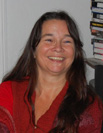alicia's web
second paper: RUTH NESTVOLD
SPACE
The action takes place in a room which isn’t described. “You
grabbed me and whirled me around the room and told me you'd been thinking
about me, hoping I would be there, so you would have another chance.”
Maybe, the reason is that the author wants that the reader imagine himself
in his room in front of the computer thinking that he is a character of
the history, he have the privilege of choosing the ending of the story.
During the text it’s reminded the city Budapest and the days that
the characters spent there. It appears as a decadent city. “The
faded glory of a former empire, in the grip of communism in its last gasp.”
Here talk about a older space, what’s more, tell us the time when
they were in Budapest, approximately in 1990, when the communism felt
down “in Budapest it was all so feudal”. There were “coffee
houses with gilded walls and restaurants with gypsy music, all for Westerners
with black market money”. Ruth also name the Halaszbastya
, “the Hungarian version of Neuschwanstein”
(we can see the Germanic influence of the author), with its towers and
turrets and promenades.
If you want to know more information about Budapest history you can visit
this page:
But overcoat she talks about the Danube because it is in the bridge where
you (the reader) said the author would never speak to her again. “Budapest
is schizo. And the Danube is gray, not blue. Everything was gray when
we were there.” When we imagine Budapest, we though it an older
grey city where the fog is around.
Budapest for characters means alcohol, poetry, wild life and spend of
money. For that this is the past which narrator misses.
One ending of the story was the next:
“You do? Then perhaps we can leave Budapest behind us.
Budapest. Where everything comes together and everything falls apart.
Where we can be whatever we want to be.
You and me and Joe.”
And then there was a link that put Budapest
where appear an image of the city.
Paris is the last place that appears in the history. When the narrator
ask if you prefer Paris rather Budapest, she said that she like more Paris
because it is clean lines, pomp and bombast. Paris is the romantic option
that the reader offered her in Budapest, but she prefers stay with Joe
in Budapest.
On the other hand, there is a choice outside the story which you can discuss
with the author about hypertext. “This is just a fiction, and as
an educated reader at the turn of the 21st century, you (the reader) do
not want to be caught behaving in a naive fashion, taking on the role
of the "you" (the character) I (the author) have created (with
your help).” http://www.lit-arts.net/JHIB/you100.htm
“I take it you prefer metaliterary discussion to having the proverbial
wool pulled over your eyes. I bet you like
John Barth and you prefer the Robert Coover of Seven Exemplary Fictions
to the Robert
Coover of Origin of the Brunists You (the reader) are an educated
person who approaches a fiction highly aware of the strategies the author
uses to lull you into the fictional world. But in this late age of print,
with the transparency of the sign on the wane, the only good author is
the non-fiction author, the author who disdains attempting to fool the
reader and discloses the conventions with intellectual games. Like me
(the author). The willing suspension of disbelief died about the same
time God did, or if it didn't, it should have.”
The space where the hypertext is localized is in this
page which you can find, apart of Joe’s heartbeat in Budapest,
the page of the author and other hypertext a
hypertextual conversation piece that connect with the story.
The work I have done in different places, first of all I read it the first
time at university. One day I caught the computer and I went to a café
and read loads of options of this hypertext. Staying in a café
help me introduce deeply in the feelings of the characters. In my bedroom
I have done the big part of the word. Finally I will go to my uncle’s
home to publish it because he has a good program for doing web pages.
© a.r.e.a./Dr.Vicente Forés López
© Alicia Aparisi Escrihuela
aes5@alumni.uv.es
Universitat de València Press
